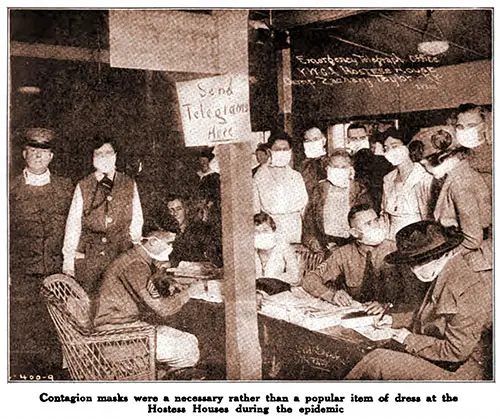The Hostess House and the Influenza Epidemic - 1918

Contagion Masks Were a Necessary Rather than a Popular Item of Dress at the Hostess Houses During the Epidemic. YWCA War Work Bulletin, 15 November 1918. GGA Image ID # 180075e995
So great was the demand for masks at hospitals around Camp Lewis, Washington, where influenza cases have been numerous, that everyone who could wield a needle and thread was pressed into service.
Even the visitors at the Y. W. C. A. Hostess House turned to, and fingers flew, to the great interest of enlisted men who strayed in.
Finally, the interest in the sport grew contagious, and several fingers unfamiliar with the small steel implement itched to try their skill at the thing. One lad gulped, and took the plunge.
“Say,” he said, “couldn’t some of us do a little sewing? There don’t seem to be much else to do.”
The ice was broken, and it grew to be a familiar sight, of an evening, to see a group of men sitting around the fire-place, on the floor, scorning chairs or thimbles, and using khaki-clad knees as pushers, much to the amusement of the sewing instructor and the discomfiture of the youths themselves.
The group one evening included two secretaries; a young second lieutenant who had just received his commission and who previous to his army service was a choir leader in San Francisco; a boy from one of the wildest of Montana ranches who spoke of everything in terms of horse vernacular; the son of a Bishop now a chaplain in the army; the son of one of our wealthiest American families, now serving as a private; a former moving picture actor ; and an opera singer.
In spite of the fact that they used their tongues steadily as well as their needles, they proved surprisingly dexterous.
All the eighty-six Hostess Houses at the various camps throughout the country have been placed at the disposal of the commandants during the epidemic of Spanish influenza.
At Great Lakes Naval Training Station, Ill., and at Camp Devens and Camp Merritt cots were brought to accommodate the women whose sons were in the hospital.
The whole of the Camp Meade Hostess House is being used as an auxiliary to the hospital.
Soldiers are allowed to buy their meals at the Camp Mills Hostess House cafeteria, but they may not congregate in the living room. Guests are entertained on the veranda.
Forty-two Red Cross nurses, called in for extra work during the quarantine, are housed in the Y. W. C. A. Players’ House at Camp Upton.
"The Hostess House and the Influenza Epidemic," in War Work Bulletin, New York: War Work Council of the National Board of the Young Women's Christian Associations, No. 48, 15 November 1918, p. 2.
